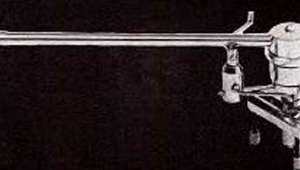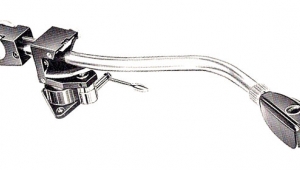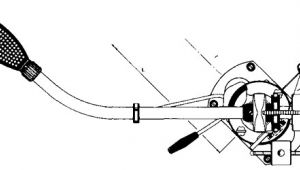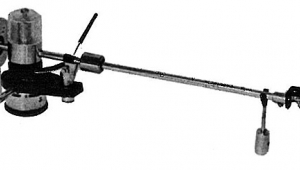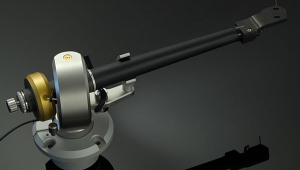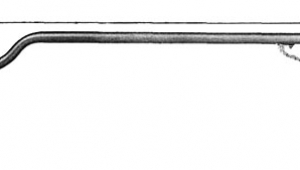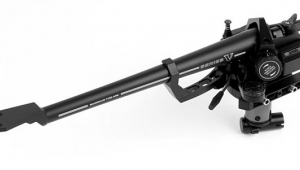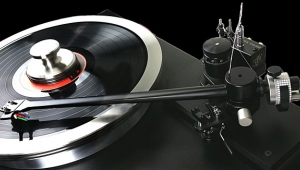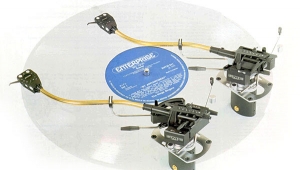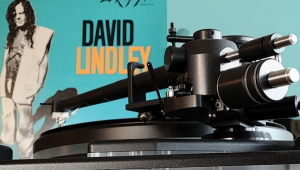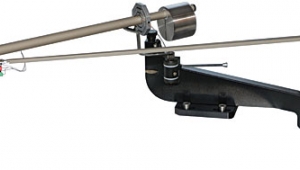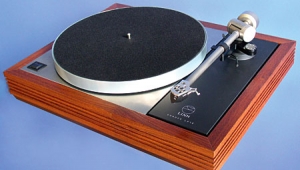| Columns Retired Columns & Blogs |
The Tri-Planar Tonearm Michael Fremer on the Tri-Planar V Ultimate, February 1998
Michael Fremer on the Tri-Planar V Ultimate, February 1998 (Vol.21 No.2):
The first review of the Wheaton Tri-Planar tonearm I can remember reading was in The Abso!ute Sound back in 1985. (Let me put that date in perspective for you: Wilson Audio's David Wilson then reviewed components for TAS, and Steven Stone reviewed records there. I had yet to write for any audio magazine.)
Over the past 12 years or so, both of the Graham and Tri-Planar tonearms have undergone extensive upgrading and refining; along the way, enough has been written about them to leave a paper trail stretching from Maryland (home of Tri-Planar) to Massachusetts (home of Graham). I could probably hike my own prose on the subject from Jersey to the Connecticut border.
The Tri-Planar (the "Wheaton" appellation has been dropped) is a complex fixed, or "enclosed" (ie, needle/cone) bearing design that features many finely machined aluminum parts and a large-diameter aluminum-alloy armtube (a tube within a tube). The build quality is superb, befitting its cost, but the Tri-Planar (like the Immedia and, to a lesser degree, the JMW Memorial), though visually striking, has more of the "handmade" appearance of a piece of scientific apparatus than the slick veneer of a commercial consumer product. It offers complete control over every setup parameter—a concept Tri-Planar's Herb Papier helped pioneer.
Over the years, Papier has upgraded the Tri-Planar to the II, the III, the IV Ultimate, and now the IVi and V Ultimate. (The V is identical to the IVi other than featuring black anodizing on the main housing. The only difference between the IV and IVi is the change to Discovery cable. The IV Ultimate arm I reviewed for TAS in a shootout with the Graham 1.5t back in 1994 is identical to the V, save for the black anodizing and Discovery wire cabling.) He's added a damping trough, replaced a junction box with a single run of arm cable from the cartridge pins to the RCA plugs (the box is available as a lower-cost option), "decoupled" the counterweights (he's inserted an elastomer damping washer), and changed the composition of the aluminum armtube to a softer alloy. The softer tube requires an aluminum tube pressed over it to accommodate the headshell tube. He's also changed the internal wiring from Cardas to Discovery.
The "whys" of these changes? Over the years, Papier has been very sensitive to criticism from reviewers and customers alike. Some (including this reviewer) felt that the Tri-Planar's high-frequency transients were a bit "sizzly," if exciting and well-defined. Some complained of a lack of bass definition and discontinuity in the top-to-bottom frequency balance. However, all of these observations were minor sonic glitches in what has been a uniformly praised and well-reviewed product.
Basic designs
The Tri-Planar mounts to the armboard via a circular three-screw plate at the base of the VTA-adjustment tower, with the bearing/armtube assembly frame attached to its side. The Tri-Planar's bearings are of superb quality. The arm itself is a two-piece affair consisting of a short arm to which the bearing assembly is attached, and a longer one riding atop, connected via a substantial, machined aluminum yoke with a double set of locking screws. Azimuth is easily adjustable via a worm-gear drive that rotates the longer armtube around its vertical axis.
An integral arm-lift/anti-skating mechanism attaches to the right side of the bearing housing. The anti-skating mechanism includes a unique "delay" feature that keeps it from tugging the arm outward when you lower the cueing mechanism. A silicone-filled damping trough is fitted to the underside of the bearing housing; an adjustable screw on the arm allows for easy control of the amount of damping applied.
The Great Debate
In order for a tonearm to hold the cartridge rigidly in place while allowing it to move both horizontally (to track the groove spiral) and vertically (to deal with the inevitable warps), the bearings must be both rigid and friction-free—almost a contradiction in terms. Which bearing system, fixed or unipivot, is better able to accommodate the seeming contradiction? Here analog fans take sides. Fixed-bearing devotees argue that because unipivots can move about seemingly infinite axes, they are unstable under dynamic conditions. Unipivot fans argue that once you've loosened a fixed bearing enough for it to move at all, you've introduced the inevitable "bearing chatter," which translates into friction, noise, and unwanted movement.
Which side is correct? Like all things in life, each argument has its strengths and weaknesses. In my experience, both systems, properly executed, can work equally well. (I hope you don't take that as a cop-out.) One thing I will not tolerate in a tonearm, pivoted or linear-tracking, mechanical or air-bearing, is bearing "slop." It doesn't make sense, and it can't make for accurate extraction of the information in the grooves, period. As with a high-quality fixed-bearing system, a properly designed unipivot does not exhibit unwanted movement under dynamic conditions.
Mechanicals
The Tri-Planar's bearings feel tight yet silky-smooth to the touch, and friction-free. With no bearing-play measuring device on hand, that's about all I can say for them. While "fixed" bearings can loosen over time, the Tri-Planar's have been field-tested for over a decade; their longevity has been proven. The Tri-Planar's three-screw mount is sturdy, but I'm somewhat troubled by the cantilevering effect of hanging all of the "goods" (bearing housing, arm, antiskate mechanism, cueing system) off the VTA mechanism. In fact, even with the VTA tower "locked," it's possible to rock it back and forth—which, of course, causes the arm to move. While no one's going to exert that kind of force during play, it brings up the issues of mechanical grounding and overall stability.
The dual-armtube system means that there is, in effect, a mechanical connector separating the arm from the bearing. But the yoke design is so massive and mechanically secure, I have no reservations about it whatsoever. The Tri-Planar's arm wiring features a single length of Discovery cable from the headshell to the RCA plugs—a real plus. If you want to play with interconnects, Papier will terminate the arm with an RCA-jack junction box. The Tri-Planar's damping system features a trough with an adjustable paddle, making it both potentially more effective than a bearing damping system, and certainly easier to adjust.
Azimuth adjustment is easy and precise via the worm-gear drive attached to the armtube, but since the armtube rotates, due to the headshell offset, the cartridge pitches forward or back, and not just side to side. In my experience, that's true of all pivoted arms save the Graham.
Cartridge setup is reasonably convenient, though I'm not comfortable fitting a delicate stylus into a hole drilled in an aluminum plate. And the system assumes the cantilever is fitted precisely in the cartridge—not always the case. I'd want to corroborate the setup with another gauge—one with hashmarks like a Wallytractor cartridge-alignment gauge (see "Analog Corner," November '97)—to be sure the cantilever rides parallel to the grooves.
Sound
Tonearms are fairly straightforward mechanical devices with an easily defined job, and whose behavior can be predicted, described, and reasonably well measured. This is not to say you can predict how an arm will sound just by its design or measurements, but I guarantee you: If an arm's vertical resonance is determined to be 25Hz, it will roll off the bass below that point.
Both of the Tri-Planar and Graham 2.0 arms measure well, with both vertical and horizontal resonances in the ideal 8–12Hz region with the cartridges I used. Both behave well on warped records, and both provide secure, rigid platforms from which a cartridge can carry out its function. Both feature easy-to-use cueing devices, and each is a pleasure to operate and optimize. And both are fun to watch working.
But they do sound different. It's been déjà vu all over again since I did a shootout like this in TAS four years ago with the 1.5t and the Tri-Planar IV Ultimate. Back then, with far less reviewing experience and technical expertise—and less bass extension in my system—I found the Tri-Planar to have a wider, "more explosive," more airy soundstage, and the Graham to present the images with more body and three-dimensionality. I found the Tri-Planar to be "more aggressive" in the upper midrange, the Graham more liquid and "reserved." I also thought the Graham's bass extension, and its ability to portray images "in three dimensions," were superior.
So now what?
The Tri-Planar
Using my standard LP references—Belafonte at Carnegie Hall, Mel Tormé and Friends at Marty's, Davy Spillane's Atlantic Bridge, Joni Mitchell's Blue, various Classic, DCC Compact Classics, MoFi, Mosaic, King Super Analogue, and others—I found the Tri-Planar's sound to be far richer and more coherent than I'd remembered it being. Top-to-bottom tonal balance was nearly ideal, with none of the excess high-frequency energy I'd previously noted, and no sense of transient etchiness or grain. This difference could be system-related, or have something to do with the neutral-sounding Discovery wire (also used in the JMW Memorial and Immedia arms).
The arm's overall presentation had a velvety smoothness, richness, palpability, and sense of relaxation that invited long-term listening, yet I didn't feel as if details of the music's structure were being smothered or attenuated to shield me from the ugly truths present on many recordings and pressings. And the arm had a fine sense of rhythmic "swing."
The Tri-Planar's bass control, articulation, and extension were superb. On tracks like Davy Spillane's "Atlantic Bridge," which has about the deepest, most well-defined bass I've heard on a record, I had no complaints about extension. Now that my system does go down to 20Hz, I suspect that, had I had the 1.5t to compare with the current Tri-Planar, I'd have found the 1.5's reach and bottom-octave authority somewhat lacking in comparison. In my original review, though I found the Tri-Planar's bass performance "never less than excellent," I thought the Graham was better. Without knowing what I'd heard with the Tri-Planar V, Herb Papier told me he thought the Discovery wire was responsible for "much-improved bass."
The Tri-Planar's relative weak suits are image focus, three-dimensionality, and soundstage depth, though it delivers a big, wide stage. Having had the superbly focused Immedia RPM arm in the system just before the Tri-Planar, I immediately noticed the reduction of depth, three-dimensionality, image layering, and solidity. The Tri-Planar simply doesn't focus as well; when I moved on to the Graham 2.0, that sense of "it's there" returned. Nor is the Tri-Planar the last word in dynamic presentation. It's very good in that regard, but both the Immedia and Graham 2.0 sounded more explosive.
However, if you find tightly focused imaging to be "unnaturally" detailed compared to live music (some audiophiles do), and if you value a coherent, harmonically rich, and essentially correct presentation, don't write off the Tri-Planar.
Conclusion
The Tri-Planar V Ultimate and the Graham 2.0 are clearly two of the finest tonearms in the world, and both have been updated and improved in the past few years. Can they be further improved? Perhaps. But as they are now, out of the box they offer a level of analog performance that puts them at the top of the heap, along with just a few other Class A arms. Earlier versions of both are upgradeable to the current versions.
The Tri-Planar is a medium-mass arm best suited for low-compliance moving-coil cartridges. It excels at portraying instrumental timbres and textures with an emotionally involving harmonic richness. Its dynamic presentation, soundstaging, and imaging, while accomplished, are bettered by a few other arms, including both the Graham and Immedia, which offer more focused, three-dimensional images, better front-to-back layering, and deeper, though not wider, soundstages. Construction quality is high. Setup instructions are adequate. Tools and an overhang jig are included in the price, as are integral Discovery wire interconnects.
These observations should be taken as general characteristics on a sliding scale, and not as definitive—associated equipment and personal taste, musical and otherwise, will affect the final result in your system. How much easier it would be to make sweeping pronouncements about which sounds the most like "live" music, about which is the "express ticket" to analog nirvana. You won't hear those from me. Both of these well-engineered arms do a good job of extracting the information from the grooves. They both "make music."—Michael Fremer
- Log in or register to post comments
